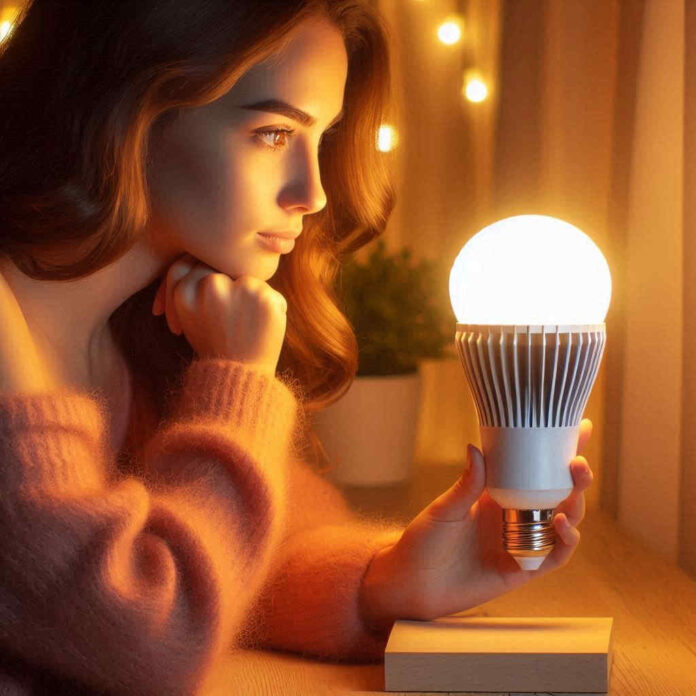
Lighting plays a crucial role in our daily lives affecting our mood, productivity, and overall well-being. With the advent of LED technology, consumers now have more options than ever when it comes to choosing the right lamp for their needs.
This comprehensive guide will walk you through the key factors to consider when selecting the best LED light bulb, from understanding light characteristics to evaluating construction and brand reliability.
Understanding Light Temperature: From Cool to Warm
One of the most important aspects of choosing an LED lamp is understanding light temperature, often referred to as color temperature. This characteristic is measured in Kelvin (K) and determines the perceived warmth or coolness of the light emitted.
At the lower end of the scale, around 2700K to 3000K, we find warm white light. This gentle, golden hue is reminiscent of traditional incandescent bulbs and creates a cozy, inviting atmosphere. It’s ideal for living rooms, bedrooms, and spaces where relaxation is key.
Moving up the scale to 3500K-4100K, we enter the realm of cool white light. This crisp, clean light is often used in kitchens, bathrooms, and workspaces where task lighting is important. It provides good color rendering and helps maintain alertness.
At the higher end, 5000K-6500K, we find daylight white. This bluish-white light closely mimics natural daylight and is excellent for detailed tasks, art studios, and spaces where color accuracy is crucial.
When choosing an LED Light Bulb, consider the primary function of the space and select a color temperature that complements the desired atmosphere and activities.
Types of LED Lamp Designs
LED lamps come in various forms, each suited to different applications:
- Bulb-style: These resemble traditional incandescent bulbs and are ideal for retrofitting existing fixtures.
- Panel lights: Flat, often rectangular fixtures that provide even illumination over a large area.
- Strip lights: Flexible LED strips that can be used for accent lighting or in tight spaces.
- Downlights: Recessed fixtures that direct light downward, popular for modern, minimalist interiors.
- Smart lamps: These incorporate wireless technology, allowing for remote control and integration with home automation systems.
When selecting a construction type, consider the existing fixtures in your space, the desired light distribution, and any specific installation requirements.
LED Physical Construction
- LED Chip: The heart of the bulb, this tiny semiconductor converts electricity into light. Its quality significantly impacts the bulb’s lifespan and lumen output (brightness).
- Heat Sink: Crucial for preventing overheating, the heat sink dissipates heat generated by the LED chip. A well-designed heat sink ensures long bulb life.
- Driver Circuit: This regulates the current flowing to the LED chip, maintaining optimal performance and preventing damage.
- Lens/Diffuser: The lens or diffuser shapes and distributes the light emitted from the LED chip, providing a focused beam or a more diffused glow.
LED Light Bulb – Reliability and Longevity
One of the key advantages of LED technology is its longevity. A high-quality LED Light Bulb can last up to 50,000 hours or more, far outlasting traditional incandescent or fluorescent bulbs. However, not all LED Light Bulbs are created equal. To ensure you’re getting a reliable product, consider the following factors:
- Heat dissipation: Efficient heat management is crucial for LED longevity. Look for lamps with good heat sink designs.
- Driver quality: The driver converts AC to DC and regulates current. A well-designed driver contributes to lamp lifespan and performance.
- Warranty: Reputable manufacturers often offer extended warranties, indicating confidence in their product’s reliability.
- Certification: Look for lamps with recognized certifications such as Energy Star or CE marking, which indicate compliance with quality and safety standards.
LED Light Bulb – Brands and Their Technologies
While many LED lamps may seem similar at first glance, leading brands differentiate themselves through innovative technologies and superior quality control. Some notable brands include:
- Philips: Known for their Hue line of smart lighting and high-quality conventional LED products.
- Cree: Pioneers in LED technology, offering a wide range of high-performance lamps.
- Osram: A long-standing lighting company with a strong focus on LED innovation.
- GE Lighting: Combines traditional lighting expertise with cutting-edge LED technology.
- Samsung: Leveraging their electronics expertise to produce advanced LED solutions.
These brands often develop proprietary technologies to enhance light quality, efficiency, and longevity. For example, some use advanced phosphor coatings to improve color rendering, while others focus on developing more efficient driver circuits or heat dissipation methods.
LED Light Bulb: Materials and Manufacturing
The materials used in LED lamp construction play a significant role in their performance and durability. Common materials include:
- Aluminum: Often used for heat sinks due to its excellent thermal conductivity.
- Polycarbonate or acrylic: Used for lenses and diffusers to shape and soften light output.
- Ceramic: Some high-end LEDs use ceramic substrates for better heat management.
- Silicone: Used in some designs for its flexibility and heat resistance.
The Manufacturing Landscape: Made in China
It’s important to note that a significant portion of LED lamps, even those from well-known Western brands, are manufactured in China. This is due to several factors:
- Cost efficiency: China’s well-developed manufacturing infrastructure and lower labor costs allow for more competitive pricing.
- Expertise: Over the years, Chinese manufacturers have developed significant expertise in LED production.
- Supply chain integration: Many LED components are produced in China, streamlining the manufacturing process.
- Scale: Chinese factories can handle large-scale production, meeting global demand.
While “Made in China” once carried negative connotations, many Chinese manufacturers now produce high-quality LED lamps that meet or exceed international standards. However, it’s crucial to distinguish between reputable manufacturers and those producing subpar products.
Why Big Brands Choose Chinese Manufacturing to produce LED Light Bulbs
Major lighting brands often choose to manufacture in China for several reasons:
- Cost-effectiveness: Lower production costs allow for competitive pricing while maintaining profit margins.
- Manufacturing expertise: Many Chinese factories have years of experience in LED production.
- Flexibility: Chinese manufacturers can often adapt quickly to new designs or technologies.
- Scalability: The ability to rapidly scale production to meet market demand.
- Established supply chains: Proximity to component manufacturers streamlines production.
However, these brands typically maintain strict quality control measures, often sending their own engineers to oversee production and ensure adherence to their standards.
Making Your Choice
When selecting the best LED Light Bulb for your needs, consider the following:
- Purpose: Determine the primary function of the light and choose appropriate color temperature and brightness.
- Quality: Look for reputable brands with good warranties and certifications.
- Efficiency: Check the lumens per watt to ensure you’re getting energy-efficient lighting.
- Compatibility: Ensure the lamp is compatible with your existing fixtures or control systems.
- Budget: While it’s often worth investing in quality, there are good options at various price points.
- Environmental impact: Consider the lamp’s energy efficiency and the manufacturer’s sustainability practices.
By carefully evaluating these factors, you can select an LED lamp that not only meets your immediate lighting needs but also provides long-term value and satisfaction. Remember, the right lighting can transform a space, enhance productivity, and contribute to overall well-being, making it a crucial element in any home or workplace design.
LED Lamp: Last advices
Armed with this knowledge, you can confidently choose the perfect LED Light bulb for your needs, creating the ideal ambiance and saving money on your energy bills.
If in the end, you haven’t defined your options and it’s not just about the technical and economic aspect, try to consult with an architect or an interior designer. The possibilities are very large and very affordable when you want to change the interior appearance of your home.



